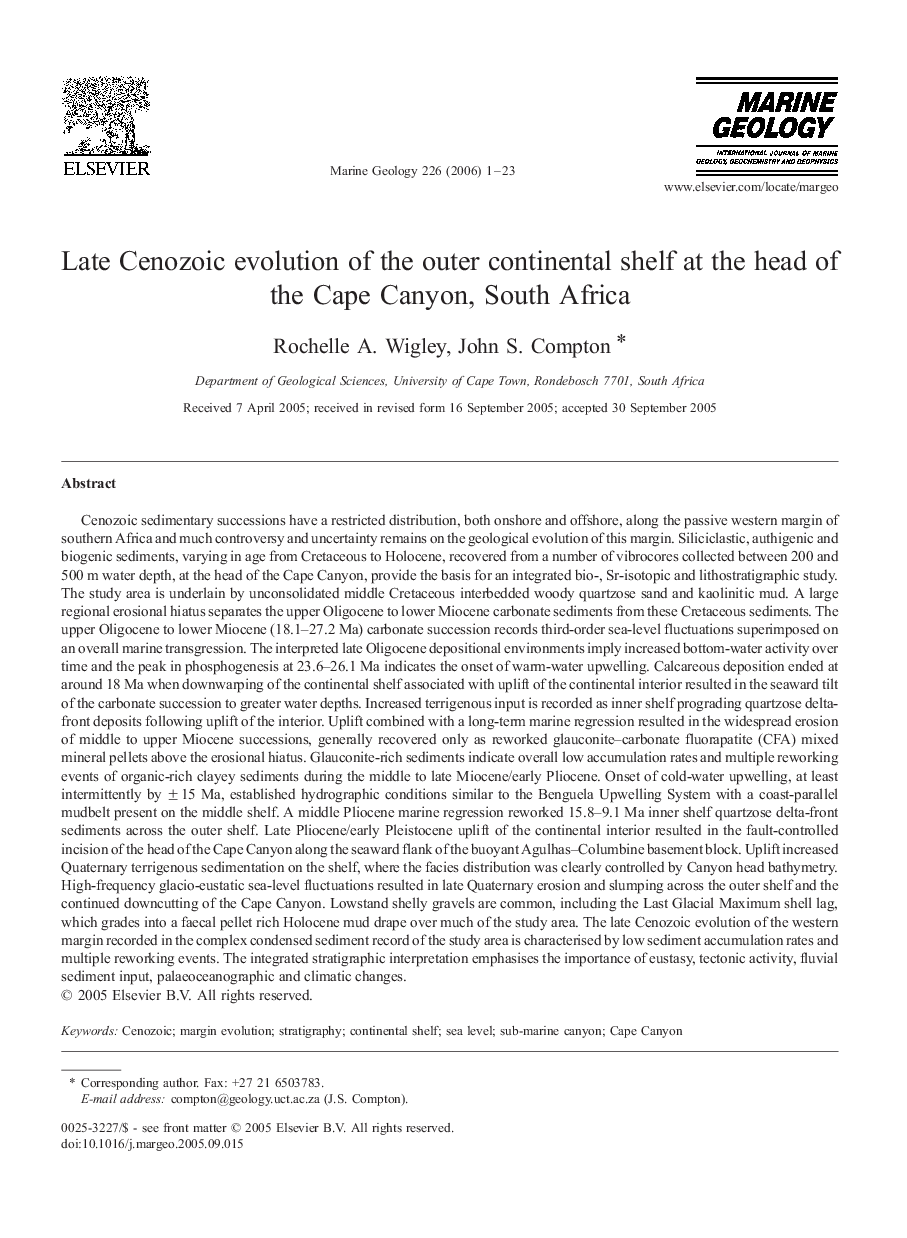| کد مقاله | کد نشریه | سال انتشار | مقاله انگلیسی | نسخه تمام متن |
|---|---|---|---|---|
| 4719747 | 1639217 | 2006 | 23 صفحه PDF | دانلود رایگان |

Cenozoic sedimentary successions have a restricted distribution, both onshore and offshore, along the passive western margin of southern Africa and much controversy and uncertainty remains on the geological evolution of this margin. Siliciclastic, authigenic and biogenic sediments, varying in age from Cretaceous to Holocene, recovered from a number of vibrocores collected between 200 and 500 m water depth, at the head of the Cape Canyon, provide the basis for an integrated bio-, Sr-isotopic and lithostratigraphic study. The study area is underlain by unconsolidated middle Cretaceous interbedded woody quartzose sand and kaolinitic mud. A large regional erosional hiatus separates the upper Oligocene to lower Miocene carbonate sediments from these Cretaceous sediments. The upper Oligocene to lower Miocene (18.1–27.2 Ma) carbonate succession records third-order sea-level fluctuations superimposed on an overall marine transgression. The interpreted late Oligocene depositional environments imply increased bottom-water activity over time and the peak in phosphogenesis at 23.6–26.1 Ma indicates the onset of warm-water upwelling. Calcareous deposition ended at around 18 Ma when downwarping of the continental shelf associated with uplift of the continental interior resulted in the seaward tilt of the carbonate succession to greater water depths. Increased terrigenous input is recorded as inner shelf prograding quartzose delta-front deposits following uplift of the interior. Uplift combined with a long-term marine regression resulted in the widespread erosion of middle to upper Miocene successions, generally recovered only as reworked glauconite–carbonate fluorapatite (CFA) mixed mineral pellets above the erosional hiatus. Glauconite-rich sediments indicate overall low accumulation rates and multiple reworking events of organic-rich clayey sediments during the middle to late Miocene/early Pliocene. Onset of cold-water upwelling, at least intermittently by ± 15 Ma, established hydrographic conditions similar to the Benguela Upwelling System with a coast-parallel mudbelt present on the middle shelf. A middle Pliocene marine regression reworked 15.8–9.1 Ma inner shelf quartzose delta-front sediments across the outer shelf. Late Pliocene/early Pleistocene uplift of the continental interior resulted in the fault-controlled incision of the head of the Cape Canyon along the seaward flank of the buoyant Agulhas–Columbine basement block. Uplift increased Quaternary terrigenous sedimentation on the shelf, where the facies distribution was clearly controlled by Canyon head bathymetry. High-frequency glacio-eustatic sea-level fluctuations resulted in late Quaternary erosion and slumping across the outer shelf and the continued downcutting of the Cape Canyon. Lowstand shelly gravels are common, including the Last Glacial Maximum shell lag, which grades into a faecal pellet rich Holocene mud drape over much of the study area. The late Cenozoic evolution of the western margin recorded in the complex condensed sediment record of the study area is characterised by low sediment accumulation rates and multiple reworking events. The integrated stratigraphic interpretation emphasises the importance of eustasy, tectonic activity, fluvial sediment input, palaeoceanographic and climatic changes.
Journal: Marine Geology - Volume 226, Issues 1–2, 1 February 2006, Pages 1–23